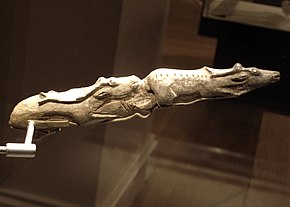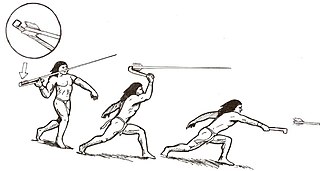
A spear-thrower, spear-throwing lever, or atlatl is a tool that uses leverage to achieve greater velocity in dart or javelin-throwing, and includes a bearing surface that allows the user to store energy during the throw.

Édouard Lartet was a French geologist and paleontologist, and a pioneer of Paleolithic archaeology. He is also known for coining the prehistoric taxon Amphicyon, making it one of the earliest-described fossil carnivorans in the palaeontological record.

The Creswellian is a British Upper Palaeolithic culture named after the type site of Creswell Crags in Derbyshire by Dorothy Garrod in 1926. It is also known as the British Late Magdalenian. According to Andreas Maier: "In current research, the Creswellian and Hamburgian are considered to be independent but closely related entities which are rooted in the Magdalenian." The Creswellian is dated between 13,000 and 11,800 BP and was followed by the most recent ice age, the Younger Dryas, when Britain was at times unoccupied by humans.

The Magdalenian cultures are later cultures of the Upper Paleolithic and Mesolithic in western Europe. They date from around 17,000 to 12,000 years ago. It is named after the type site of La Madeleine, a rock shelter located in the Vézère valley, commune of Tursac, in France's Dordogne department.
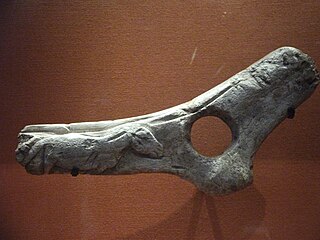
Perforated baton, bâton de commandement or bâton percé are names given by archaeologists to a particular type of prehistoric artefact made from antler from Prehistoric Europe, whose function remains debated. The name bâtons de commandement was the name first applied to the class of artefacts, but it makes an assumption of function, as a ceremonial object or insignia held by leaders. The name bâton percé, meaning "pierced rod", or "perforated baton" is a more recent term, and is descriptive of form rather than any presumed function.

Bone carving is creating art, tools, and other goods by carving animal bones, antlers, and horns. It can result in the ornamentation of a bone by engraving, painting or another technique, or the creation of a distinct formed object. Bone carving has been practiced by a variety of world cultures, sometimes as a cheaper, and recently a legal, substitute for ivory carving. As a material it is inferior to ivory in terms of hardness, and so the fine detail that is possible, and lacks the "lustrous" surface of ivory. The interior of bones are softer and even less capable of a fine finish, so most uses are as thin plaques, rather than sculpture in the round. But it must always have been much easier to obtain in regions without populations of elephants, walrus or other sources of ivory.
Montastruc is a commune in the Tarn-et-Garonne department in the Occitanie region in southern France.

Bison Licking Insect Bite is a prehistoric carving from the Upper Paleolithic, found at Abri de la Madeleine near Tursac in Dordogne, France, the type-site of the Magdalenian culture, which produced many fine small carvings in antler or bone.

The Hohle Fels is a cave in the Swabian Jura of Germany that has yielded a number of important archaeological finds dating from the Upper Paleolithic. Artifacts found in the cave represent some of the earliest examples of prehistoric art and musical instruments ever discovered. The cave is just outside the town of Schelklingen in the state of Baden-Württemberg, near Ulm. Because of the outstanding archeological finds and their cultural significance, in 2017 the site became part of the UNESCO World Heritage Site Caves and Ice Age Art in the Swabian Jura.

The art of the Upper Paleolithic represents the oldest form of prehistoric art. Figurative art is present in Europe and Southeast Asia, beginning between about 40,000 to 35,000 years ago. Non-figurative cave paintings, consisting of hand stencils and simple geometric shapes, are somewhat older, at least 40,000 years old, and possibly as old as 64,000 years. This latter estimate is due to a controversial 2018 study based on uranium-thorium dating, which would imply Neanderthal authorship and qualify as art of the Middle Paleolithic.
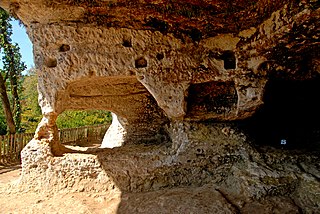
The archaeological site Abri de la Madeleine is a rock shelter under an overhanging cliff situated near Tursac, in the Dordogne département of the Aquitaine région of southwestern France. It represents the type site of the Magdalenian culture of the Upper Paleolithic. The shelter was also occupied during the Middle Ages. The medieval castle of Petit Marsac stands on the top of the cliff just above the shelter.

The Mammoth spear thrower is a spear thrower in the form of a mammoth, discovered at the "Montastruc rock shelter" in Bruniquel, France. It is from the late Magdalenian period and around 12,500 years old. It now forms part of the Christy Collection in the British Museum, and is normally on display in Room 2. Between 7 February – 26 May 2013 it was displayed in the exhibition at the British Museum Ice Age Art: Arrival of the Modern Mind.

Laugerie-Basse is an important Upper Paleolithic archaeological site within the territory of the French commune Les Eyzies-de-Tayac-Sireuil in Dordogne. It is known for several works of art from the Magdalenian. In 1979, Laugerie-Basse, along with other nearby paleolithic sites, was inscribed on the UNESCO World Heritage List as Prehistoric Sites and Decorated Caves of the Vézère Valley.
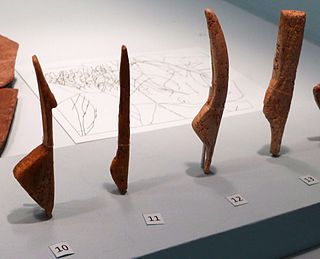
The Venus figurines from Gönnersdorf, at Neuwied, are paleolithic sculptures depicting the female body.

An example of the art of the Upper Paleolithic in the Last Glacial Period, this decorated fragment of a perforated antler baton was discovered in 1863 by Edouard Lartet and Henry Christy at the Abri de la Madeleine, an overhanging cliff situated near Tursac, in the Dordogne département and the Aquitaine Région of South-Western France. This is the type-site for the Magdalenian culture, currently dated to around 17,000 to 12,000 years ago. It was bequeathed to the British Museum by Christy, and is now catalogued as Palart 310, but not normally on display.

The Montastruc decorated stone is an example of Ice Age art, now in the British Museum. A human figure that appears to be female has been scratched or engraved to decorate a fragment of limestone used as a lamp. The piece was excavated from Courbet Cave, Penne, Tarn, Midi-Pyrénées, France, on the northern bank of the river Aveyron, a tributary of the Tarn. It is dated to around 11,000 BCE, locally the Late Magdalenian culture during the Upper Palaeolithic, towards the end of the last Ice Age. It was excavated by Edouard Lartet and Henry Christy in 1863, and among other items bequeathed to Christie's museum.

The Vogelherd Cave is located in the eastern Swabian Jura, south-western Germany. This limestone karst cave came to scientific and public attention after the 1931 discovery of the Upper Palaeolithic Vogelherd figurines, attributed to paleo-humans of the Aurignacian culture. These miniature sculptures made of mammoth ivory rank among the oldest uncontested works of art of mankind. Because of the cultural importance of these sculptures and the cave's testimony to the development of Paleolithic art and culture, in 2017 the site became part of the UNESCO World Heritage Site called Caves and Ice Age Art in the Swabian Jura.

The Cave of Aurignac is an archaeological site in the commune of Aurignac, Haute-Garonne department in southwestern France. Sediment excavation and artefact documentation since 1860 confirm the idea of the arrival and permanent presence of European early modern humans during the Upper Palaeolithic. The eponymous location represents the type site of the Aurignacian, the earliest known culture attributed to modern humans in western Eurasia. Assemblages of Aurignacian tool making tradition can be found in the cultural sediments of numerous sites from around 45,000 years BP to around 26,000 years BP. In recognition of its significance for various scientific fields and the 19th-century pioneering work of Édouard Lartet the Cave of Aurignac was officially declared a national Historic Monument of France by order of May 26, 1921.
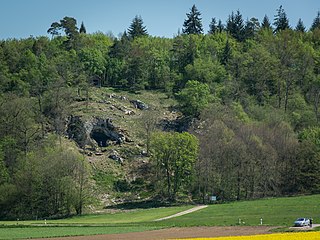
The Bockstein Cave, German: Bocksteinhöhle is part of the Bockstein complex – a White Jurassic limestone rock massif. The 15 by 20 m rock shelter, among small peripheral caves is situated around 12 m (39 ft) above the Lone River valley bottom, north of the towns of Rammingen and Öllingen, Heidenheim district in the central Swabian Jura, southern Germany. Several small openings, that are the actual entrances to the site, lead to various cave sections. The large frontal opening is of modern origin, created during the first excavation works in the late 19th century.
